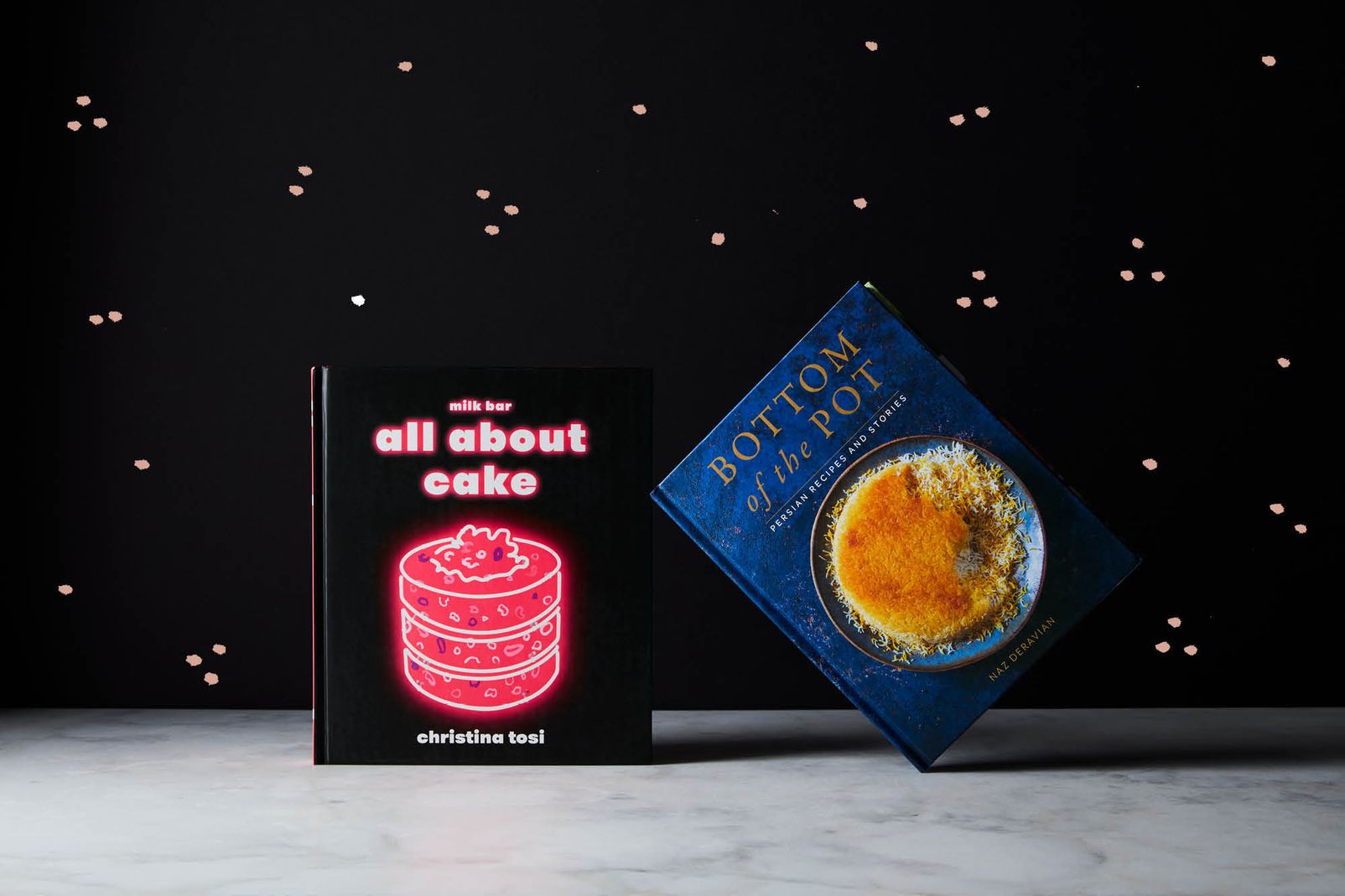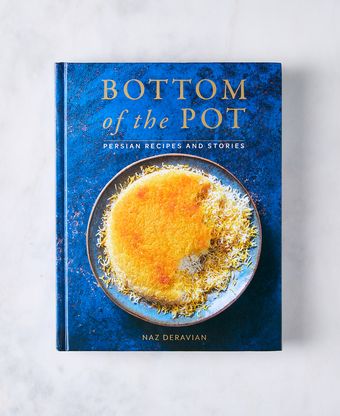I am an incredibly picky eater. I am not proud of this, but I am 44 years old and my palate is not likely to become more sophisticated in what remains of this life. I am not only picky, I am also not adventurous. I have no inclination to eat a broad range of foods. I like what I like. I hate what I hate.
Avocado, for example, is the stuff of my nightmares. To me, the texture is all wrong. I think it is mushy and bland, and the world’s obsession with avocado is something that keeps me up at night. I am allergic to seafood and shellfish, so any recipes that involve those ingredients are immediately out. I hate eggplant, because I find it to be mushy and bitter. I don’t like soups or stews. I don’t like most grains. (I’m a real treat as a dinner guest!) I could go on, as the list of foods I will not eat is long, but that’s not what this is about.
When I considered All About Cake by Christina Tosi, and Bottom of the Pot: Persian Recipes and Stories by Naz Deravian, I naturally gravitated more toward All About Cake, because I love cake. Cake is delicious. Frosting is delicious. And I knew nothing about Persian cooking, so I worried that I wouldn’t find anything in Bottom of the Pot I could enjoy, given my desperately immature palate.

Some time ago, I watched Tosi’s episode of Netflix’s Chef’s Table with great interest, because she talks about food—dessert, specifically—in such passionate, accessible, and authentic ways.
It was surprising, then, that All About Cake is not terribly accessible. I love to bake and am pretty good at it. What I particularly enjoy about baking is the precision—measuring things and combining things and applying heat or cold and seeing what happens. Baking also makes you a pretty popular person, because people always enjoy eating baked goods. I make a mean chocolate chip cookie, as well as some lovely banana bread with a brown sugar crust, and I love making Ina Garten’s brownie pie, only I add white chocolate to the recipe to really drive the decadence.
All About Cake offers many hallmarks of a great cookbook. Tosi begins with her personal story, talking about how she hasn’t always loved cake, and explaining how she came to change her mind. She establishes her guidelines on what makes a cake good, which I think are worth listing here. A good cake must have a strong point of view and flavor story. Each layer should be delicious on its own. There should be unexpected textures. Finally, a cake shouldn’t be hidden behind frosting, so Tosi doesn't frost the sides of her cakes. I was with her until this last guideline, because frosting is awesome. I don’t need to see what’s going on in each of a cake’s layers to appreciate the flavor and composition. Give me that butter and sugar whipped into creamy goodness, and slather that delicious cake with it!
In the opening pages, Tosi also offers definitions of key baking terms and what she views as essentials for baking. She closes with some life lessons that aren’t particularly groundbreaking or innovative, but "common sense" is so named for a a reason. Smart, humane ideas about being in the world always bear repeating. But shortly after these ideas, Tosi gets right to the recipes. In many ways, the front matter feels kind of perfunctory, abbreviated. I suppose, having seen her episode of Chef’s Table, I wanted a bit more from her because I find her way of seeing the world endlessly interesting. This may not be a fair expectation.
The theme of this book is singular—cakes—but in its pages there are all manner of cakes to be baked: Bundts and pound cakes, hot cakes, sheet cakes, cupcakes, cake truffles, layer cakes, and even a slender section of vegan cakes for those living that plant-based life. I was supposed to try three recipes from this book, but I struggled in selecting them. Each of the recipes is clear and concise, but also...not. Most of the cakes had multiple subrecipes. With the Burnt Miso Pound Cake, for example, there was the recipe for the actual cake, and one for apple compote, and one for sour whipped cream. The Baller Birthday Sheet Cake consisted entirely of four different subrecipes.
It was overwhelming trying to find a recipe that felt manageable. (And I didn't want to bake mug cakes because those recipes just didn't appeal to me or feel like "real cake.") I was just not up to the task. I am all for taking chances, and I can handle complexity, but in my mind a cookbook is supposed to allow regular folks to make interesting food, in their own homes. As I read through this book, I never found a recipe I felt comfortable attempting. I thought, from one page to the next, “I would love to eat this cake, if someone else would bake it.”
What impressed me about All About Cake, however, was the sheer imagination of Tosi’s recipes. The Compost Pound Cake offered a mix of savory and sweet. The Popcorn Cake Truffles conjured popcorn, but in a cake. What could be better? The Dulce de Leche layer cake promised rich, sweet, creamy goodness. It was all a wonderland of confection—if only it felt possible to make on my own.

Naz Deravian’s Bottom of the Pot was a much different cookbook. It had a warmth and depth I found extremely compelling. Deravian opens the book with an essay about home, family, Iran, and how so many of her memories are interwoven with a simple ingredient: rice. It is a lovely bit of writing and I was excited to read her perspective on food, particularly because I am not at all familiar with Persian cooking. In the book’s introduction, Deravian offers a tidbit about her mother’s recipes that I can relate to: How the recipes her mother shared were mostly just lists of ingredients. I am Haitian–American, and often try to get recipes from my mother, who shares them in similar ways—a list of ingredients, always-changing instructions that seem to leave out critical measurements and recipe steps.
Deravian really shines when explaining the tenets of Persian cooking. She shares the staples of a well-stocked Persian kitchen, defines the Persian palate, and provides recipes for commonly used spice blends. Each section of recipes opens with an essay about memory and culture and how they are intertwined with food. The recipes themselves are beautifully written and photographed. Most of them include brief headnotes with information about the recipe, and/or useful tips to keep in mind as you prepare them.
As I said earlier, I am a very picky eater, so there were a great many recipes in this book that seemed lovely but that I was never going to try. Still, I ended up selecting four recipes that did sound good to me. All of them were fun and easy to make, though certainly some of them took some time. The recipes I chose appealed even more to me because they all contained parsley, and I am a big fan of parsley. It’s weird, I know, but I will gladly fuck up some parsley, whenever I can.
Winter has been long and kind of dreary so I wanted to cook spring into emerging. I began with the Tomato Cucumber Salad, which married some of my favorite foods: cucumbers (yes, really), tomatoes, green onions, and parsley. There is something deeply satisfying and relaxing about slicing a cucumber thinly and neatly. Once the cucumber was ready, I added basil and fresh mint, all of these tossed in the recipe’s vinaigrette. One of the best things about Deravian’s recipes is how colorful they are, both visually and on the palate. As I assembled the salad, I loved seeing the colors come together. I loved smelling the freshness of the herbs. And the flavors were complex. To elevate cucumber, which is not the most exciting vegetable, and even infuse it with flavor, is no small feat.

I also made the Cabbage Salad using red cabbage, carrots, green onion, a ton of parsley, fresh orange juice, fresh lemon juice, olive oil, and red wine vinegar. This salad is outstanding—bright and crisp and flavorful. It was even better the second and third days, as the flavors mingled and marinated.
Cherries are my favorite fruit, so I decided to stretch myself a bit and make the Sour Cherry and Feta Crostini, an hors d'oeuvre that will absolutely be part of my dinner party rotation. There are cherries to bring to a boil. There are nuts to crush (all in a feminist’s day’s work). I felt very fancy as I drizzled olive oil on the crostini after I toasted the sliced baguette. The finished product was a marvel of textures and flavors—crunchy and soft, sweet and savory. It also looked gorgeous when plated.
To round things out I made Goosht Ghelgeli, or meatballs, prepared with ground beef, lamb, turkey, or chicken. I picked beef and combined it with various spices, grated onion, and crushed garlic, along with bread crumbs and egg to bind the meatballs. And though the recipe didn’t call for it, I also threw in some fresh parsley. Things went a bit awry as I baked the meatballs, because I am in a new house and am still learning the quirks of my oven. The bottoms of the meatballs were, shall we say, very well done. Next time—and I will be making these meatballs again—I know to shorten the cooking time. But even with the slight overcooking, the meatballs tasted wonderful, and flavorful. I enjoyed the unexpected combination of dried mint and cinnamon and turmeric in a delightful parcel of meat.
The recipes in Bottom of the Pot are versatile and smart and soulful. Deravian’s passion for cooking and for home is deeply felt from the first page to the last. I’m pretty sure my choice for the winner of this round has been clear from the beginning, and that’s fine. Sometimes you know the ending and want to figure out how we got there anyway. Bottom of the Pot was, by far, the cookbook I enjoyed and appreciated the most—coming from someone who loves to read and loves to cook but was not at all expecting to enjoy reading and cooking and eating beyond her comfort zone.



59 Comments
Generally speaking, the cake batters are tasty, and baking them in sheet pans is easy. Cutting them out is fun. Typically the "crunches" and the "soaks" are tasty. Things can go awry with the frostings and the jams. I agree with the many who have found things too sweet: there is usually one component that makes one's teeth hurt. But once you've figured out that your sugar tolerance is lower than Tosi's, you can adjust.
If you are happy to sit down and spend a few minutes developing a plan on Monday to eat cake on Sunday, and would like to have a "cake formula" where you use an identical method to produce different flavoured cakes, and would not like to spend time learning traditional cake decorating techniques, then this book is for you.
Copping out on the recipes is like sitting down to read one of Roxane Gay's stories and saying "oh well I don't care for the character development, lets just skip all that useless character description and plot development and jump right into the last few pages. Let’s then judge Roxane Gay and her work on a less than full understanding of everything that happened in the story.” That is precisely what she did did to Christina Tosi and it’s shameful.
Additionally, and most importantly, it is a disservice to the reader of the review. I read these reviews hoping to learn more about the cookbooks and IF the recipes work. I can sympathize with readers here who only care to get an assessment of the book’s difficulty level, but the reality is that Roxane Gay could have done a service to all factions by trying a recipe, and then commenting on the difficulty of the recipe, the inane nature of it and the result. IF it is true that Christina Tosi’s cakes result in a saccharine mess (as one reviewer put it, and which is something that I have heard a few too many times to feel secure about buying and baking from one of Ms. Tosi’s books) then I really want to know that before wasting my own time and energy. By the simple replication of the “mug cake recipe”, Ms. Gay would have been able to comment on the amount of sugar that went into the confection and if it was an appropriate amount. Clearly she didn’t care to help any of us out on that front.
On the other hand, per her own admission, Roxane Gay does not have the physical tools that it takes to be successful as a baker. Rule # 1 is OWN AN ACCURATE OVEN THERMOMETER. Even if Roxane Gay had tried the recipes, she herself would have (more than likely) failed, yielding dry, nasty cakes. We would not be able to discern if the error was the result of a poorly written recipe by Christina Tosi or simply due to Ms. Gay’s oven.
In summation, it is best that Roxane Gay did not attempt to make the recipes, but it is still disappointing. Does she not have any friends or family that could have helped her meet her commitment of baking A cake? This sort of thing has repeatedly happened in the past though. Perhaps Piglet should screen for the author’s ability and willingness to deal with fussy recipes. 10 years ago, Grace Parisi was handed what is likely one of the greatest modern-day cookbooks ever written (literally, every recipe is a show-stopper taste-wise), but she rejected it because it was too complicated and precise of a book. However, the difference there was that Grace Parisi put in a solid effort and actually attempted the recipes. Her opinion while debatable was valid. Just this year, Andrew Knowlton rejected an incredible, but fussy book (Noma Guide to Fermentation), but Knowlton put in a solid effort, tried the recipes and wrote an excellent and respectful review. That should not be too much to ask.
In Roxane Gay’s defense and at the very least, she was not flippant in her laziness, so we have that to be thankful for. Additionally, I have seen the word “outrage” tossed around in the comments section. Situations like this: https://www.smithsonianmag.com/smart-news/joshua-tree-national-park-could-take-200-300-years-recover-shutdown-180971379/ warrant outrage. So for clarification purposes, I am not expressing outrage, but rather disappointment. Plus, no matter how many accolades Christina Tosi might have, she deserves to be defended. Perhaps reading this might make Christina Tosi feel better if, as Allison Robicelli put it last week, Tosi “labored over this with every part of her being” for what felt like an eternity.
Lastly and on a very positive note, I had to double-check that I spelled Allison Robicelli’s name properly. Google pulled up her tweet about, Atticus, Toby and the Thigh-master. I highly recommend that everyone on the forum look that up. Wow…. she is hilarious!!!
She made two salads, meatballs and some crostini, all from one book while spending PARAGRAPHS justifying her unwillingness to keep to her agreement.
I guess every Piglet has to have at least one reviewer who WASTES OUR TIME so we can all get annoyed that the editors of Food52 don’t bother enforcing their own rules or treat the subject matter with actual respect.
But hey - she made her word count, and now her resume will show she “judged a Piglet” so whatever.
*BUT she's not the average customer: she agreed to try recipes from the book and review them; she did not do this. I'm in the baking club so I'm familiar with people's views on Tosi's baking - I've heard other people say her recipes are no walk in the park. Really though, no tries at anything? Not even the banana bread? Mug cakes aren't cake-y enough but real cakes are too hard? Sure the miso pound cake has a compote and sour whipped cream, but a quick look at the recipe posted on food52 reveals these extra components are 1) not difficult and 2) toppings, so she could still have made a basic pound cake and at least reviewed that. Ms. Gay say's she's a good baker, but after reading her review I don't buy it!
I live in New York City and have sampled Ms.Tosi’s desserts from time to time. I have always found them to be too sweet, too salty, too weird, too big, and too much.